In the News
Vancouver Island Garden Railway Club ( VIGRC) Spring Operations Session
May 30, 2007


By Dave Marecek |
Author
Bio
The Vancouver Island Garden Railroad Club exists to encourage one another in a shared interest, to help one another with new ideas, to enjoy the diversity of every train layout, to make lasting friendships, and to clear the goody table by the end of each and every gathering.
|
The Vancouver Island Garden Railroad Club exists to encourage one another in a shared interest, to help one another with new ideas, to enjoy the diversity of every train layout, to make lasting friendships, and to clear the goody table by the end of each and every gathering. http://www.vigardenrailway.com 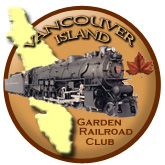 The club members live all over Vancouver Island with the farthest members being a 3 hour drive apart ( Note this is about half way up the island) , so to see most of the members out for the Spring Operating Session at the Lone Firr RR was great, as many members made the 3 hour drive to become engineers for the day.
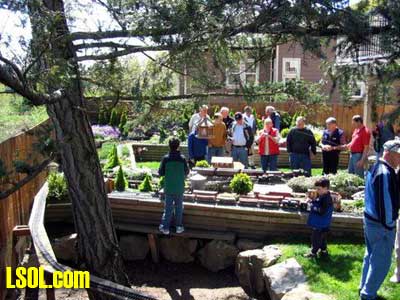 The Lone Firr RR is modelled on Vancouver Island in 1910 and represents the towns of Duncan, Chemainus, Ladysmith and Nanaimo on the mainline Esquimalt and Nanaimo Railway (E&N) right of way. Esquimalt is in the train storage shed and is reached on a spur that runs out of Duncan.. 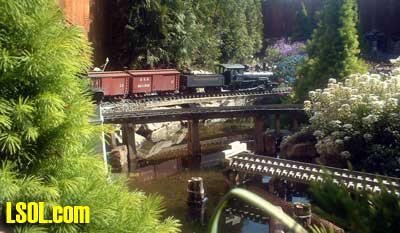 The Victoria Lumber and Manufacturing Co Railway (VL&MCo) has it headquarters in Chemainus . The VL&MCo operates from a logging spur that follows the Chemainus River with a ruling 3.5% grade from the tall timber onto the E&N Mainline and ends in Ladysmith at the log dump. The VL&MCo also uses the E&N Mainline to haul logs from Lake Cowichan via Chemainus to the Ladysmith log dump.
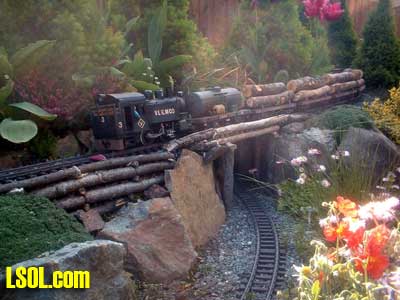 The layout was designed for Operations and follows a dog bone plan. The mainline is about 250? long with passing sidings at Chemainus, Ladysmith and Nanaimo with the remainder being single track. There are reversing loops at Duncan and Nanaimo that exit the yard through the fence into a holding track and then return through tunnels at a different point representing a different departure location. Also there is a mainline diamond crossing just before the Chemainus River Bridge. 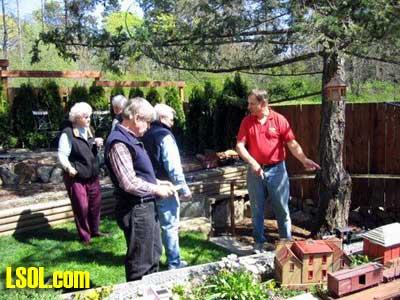
As host for the day, I was the dispatcher and taught each new engineer the rules and the RC controls. I am wearing the red shirt in the pictures trying to teach new engineers, track the movement of 4 trains, assign passing sidings, avoid train wrecks at the diamond and socialize.
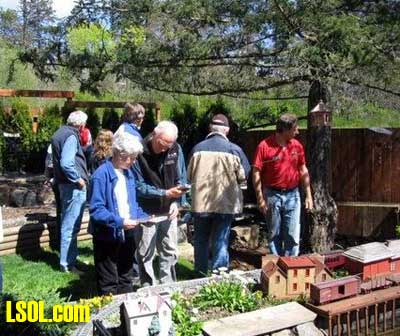 Rules of Operations for the Lone Firr are simple. Passenger has priority over freight which has priority over logging trains and Northbound has priority over Southbound. The only 3 binding rules are the passenger train has to stop for at least 2 minutes at all stations on the platform track, both North and Southbound. Any train on a reversing loop has to hold in the hidden staging for 2 minutes prior to coming back onto the mainline. Every steam engine has to fuel and water once per circuit for 2 minutes. 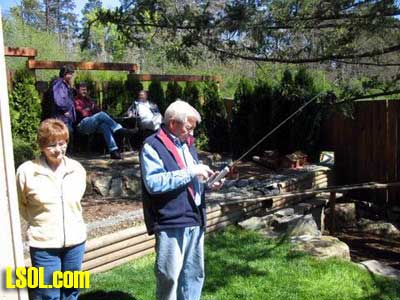 The engines are all radio control (75mhz TE) with Lithium Ion Batteries for power. Most engines also have sound cards/speakers all of which is stuffed into tenders. For the event I purchased a second Transmitter so that we could operate with 2 Engineers, 2 Brakemen and 1 Dispatcher. All turnouts are manual, so the Brakemen were kept busy at all passing sidings. It was, after all, a social event and union rules demand coffee breaks every 15 minutes so we continuously changed Engineers and Brakemen.
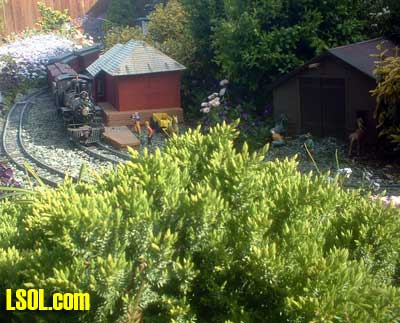 There were two E&N Mainline trains, one passenger pulled by a 4-4-0 and one freight pulled by a 4-6-0 assigned to the E&N Engineer. There were also two VL&MCo Logging Trains assigned to the VL&MCo Engineer, a 2-6-0 Mogul and a 0-4-0 Tank Engine. 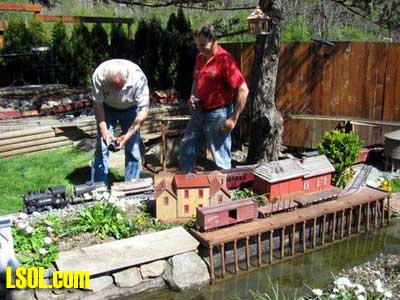 The weather started out wet in the morning as the meet was on 22 April, but by the time everyone arrived at 1 PM, the sun was shining and we had a wonderful day in the garden until 4pm. The pictures are courtesy of Paul Roberts who hung on to his camera and stayed away from the controls. ( A safe bet).
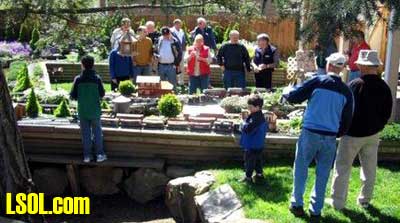 I like to set all the engines to a maximum momentum, so there were more than a few emergency stops during the day as the running distance between some stations is only long enough to pull out of the yard, get to speed and slow down for the next yards limit. If you started talking to the brakeman, you could guarantee trouble ahead as the yard limit signs came up fast and the braking of a train full of logs took at least 30+ sec to come to a full stop. 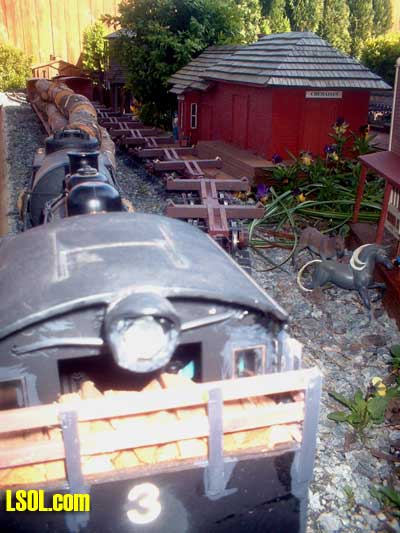 The challenge of the day was keeping the 4 trains running continuously. New engineers/brakemen were limited to 1 train in motion at first until they had completed an entire loop. Once they felt comfortable, they graduated to 2 trains in motion. For most of the day we had 2 trains in motion with the other 2 holding on passing sidings.
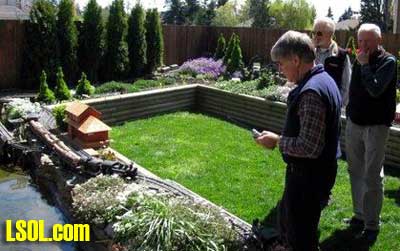 At one point, the dispatcher lost control and we ended up with both sidings in Chemainus and Ladysmith with all 4 trains pointing boilers at each other. Fortunately one of the trains at Ladysmith was a VL&MCo Logging train which we backed onto the log dump. This cleared a passing siding and allowed the dispatcher to push the E&N freight through and get things back on schedule with a little highballing. Of course while this was happening every club member present had some comment about the dispatcher?s ability to control things. 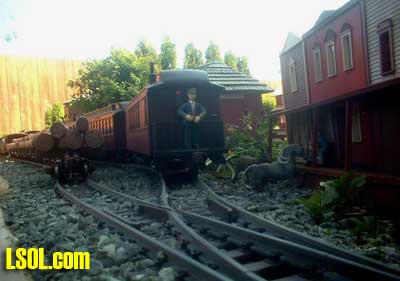 Later in the day one of the members fired up his Aristocraft live steam Shay and we let it loose on the mainline. The E&N mainline was built with a 0% grade throughout for Live Steam operations so it was great to see it slowly moving across the mainline. With Battery /RC controls, we followed the Shay with other trains with the Engineer paying close attention to the distance to the Shay.
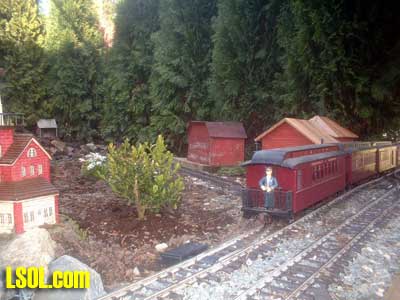 Overall a great day was had by the club members and all engineers/brakemen passed with flying colours. For additional information on the club plus pictures of other club member railway?s, please click onto http://www.vigardenrailway.com and enjoy the Vancouver Island Garden Railways
Top of Page
|



